THE CONDITION of THE BODY
Photo: LOC
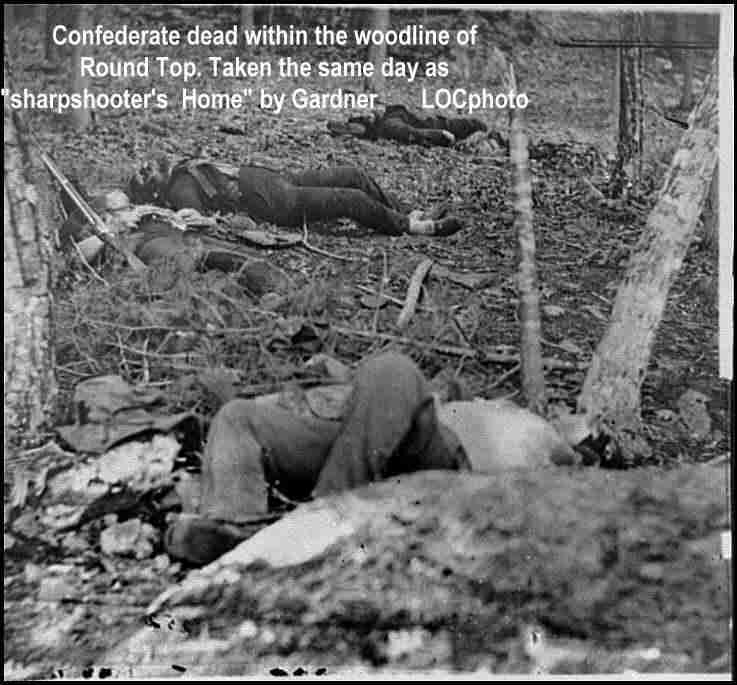 Historians, authors, re-enactors, guides, etc. (and artists too), have
agreed this body belonged to
a regiment fighting in the "triangular field" area of the southern
termination of Houck's Ridge
on Thursday, the 2nd of July and second day of the battle.
However, if this were true, this body-supposedly found down the hill-
would have lain in the open for several days. By the time the photographers
found it, this body would be just as bloated and grotesque as all the other
bodies found and photographed in the area. Even a group of confederates
killed within the somewhat
shaded wood-line at the base of Round Top on the 2nd show
horrible bloating. These soldiers-I think Georgians killed by a case-shot
spray pattern from one of James Smith's Fourth N.Y. Battery rifled 10 PDR
Parrotts-were left to lay throughout the 3rd
(Friday), which was the hottest, most sunlit day of all occurring between
the time of battle and the
arrival of the photographers (for bloating, a day of heat and sunlight is
key for the necessary
fermentation to occur). After the 3rd, the weather turned cloudy
and
thunderstorms moved through the area. The photographers most likely took
this photo (as well as the sharpshooter's) on Tuesday or Wednesday, and,
according to all the photographs taken that day, the weather was still
overcast.
Historians, authors, re-enactors, guides, etc. (and artists too), have
agreed this body belonged to
a regiment fighting in the "triangular field" area of the southern
termination of Houck's Ridge
on Thursday, the 2nd of July and second day of the battle.
However, if this were true, this body-supposedly found down the hill-
would have lain in the open for several days. By the time the photographers
found it, this body would be just as bloated and grotesque as all the other
bodies found and photographed in the area. Even a group of confederates
killed within the somewhat
shaded wood-line at the base of Round Top on the 2nd show
horrible bloating. These soldiers-I think Georgians killed by a case-shot
spray pattern from one of James Smith's Fourth N.Y. Battery rifled 10 PDR
Parrotts-were left to lay throughout the 3rd
(Friday), which was the hottest, most sunlit day of all occurring between
the time of battle and the
arrival of the photographers (for bloating, a day of heat and sunlight is
key for the necessary
fermentation to occur). After the 3rd, the weather turned cloudy
and
thunderstorms moved through the area. The photographers most likely took
this photo (as well as the sharpshooter's) on Tuesday or Wednesday, and,
according to all the photographs taken that day, the weather was still
overcast.
Thus, everybody killed on the second day would be exposed to terrific
warmth throughout the
third day. Decay and bloating would accelerate with the heat. My point
being that if this fellow
was killed on the second while fighting for the acquisition of Houck's
Ridge, then his body
would be looking as horrific as everybody else's. But it isn't. It's not
even close. It may then be
assumed that this particular body was not exposed to the same degree and
length of heat as those
meeting their fates on the second day.
With this in mind, we can now entertain the possibility that this fellow
may actually be a
sharpshooter in position behind his wall and between the two massive
boulders. He is doing his
duty trying to negate the arty crews atop LRT on the third of July
(Friday). He is killed in that location on that day instead; and
therefore his body is some 18 hours "newer" than the other dead soldiers
found and photographed in that battle area. Thus, his body does not
experience the full "hottest" day treatment which doubtless was the primary
cause for the horrid swollen appearance of all the other bodies
photographed Monday and Tuesday on the battlefield.
Click here for photos
Further, if he is killed in this location, he is surrounded by
sunlight-blocking boulders and a still
substantial, cooling-effective, stone-enclosure on three sides. In
addition, according to the
diameter of the deciduous tree stump just visible in the lower right corner
of both stereo and
plate made at this spot, a fifteen to twenty-foot tree is providing shade
(You can see this tree's
stump visible in the lower right foreground of photos 1, and 2. This tree
has apparently been
sawn down and removed to provide the best camera view of the dead
sharpshooter. Scions
growing upwards from around its' base have been stomped down and out of the
way). The dead
soldier's body temperature would remain cooler at this position than a
position upon the open
and lower (DOWN the hill location) South-West hillside. Therefore his body
would be in a
much better condition by the time he is found by the photographers on
Tuesday.
The Flattened Legs
There is another difference between the condition of this body and the
others found and
photographed by Gardner, O'Sullivan , and Gibson. Take a good look at
photograph 4. Notice
the lower legs. They are crushed FLAT. The feet are pointing in opposite
directions. This is
not possible unless something of heavy weight has been resting upon this
fellow's legs for some
time. Photo: LOC
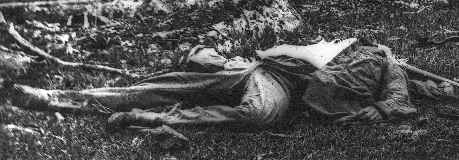
I could discern no other body recorded
upon the battlefield which exhibits these
crushed and so obviously flattened legs
(typically their knees are elevated). And so
it is a very curious anomaly.
The question is simply this: in which of these two positions, UP at the
wall or DOWN on the
open hill-side, would the body be more likely to be found with something
heavy lying upon his
lower extremities? Notice I say "lower extremities", for if this soldier
had been buried by his
companions with stones or whatever, his entire body would be flattened
after several days
duration. There is nothing about the rest of the upper body indicating it
was covered by anything. Hence, there is no reason to believe he was buried
at any time before the photographers found him.
Returning to the simple question, the wall and boulders, of course, is
the most likely place--especially if part of the wall had collapsed upon
this unfortunate soldier during battle. Although the reader cannot
discern rocks laying on the soldier's legs in either photograph made at the
wall "Home" (the photographers having removed them for the proper effect)
we cannot throw out the obvious condition of the legs. Further, the
flattened effect of the legs is not the only evidence showing the
possibility of a wall-collapse.
I will call your attention to photograph one.
Click here for photos
Notice the stiff and elevated condition of the man's coat. Strangely, it
does not lay flat upon and over his chest. In fact it has all the
appearance of being pulled up and over the body's chest area by the
photographers. I submit that the photographers found the soldier lying in
his "home" with his coat actually opened and lying to the side of the
body-over the left arm- and upon his haversack and ground. After being
open for several days and being sodden from the various rains, this coat
had taken on the plastic character of whatever it was laying across. It
has become "impressed" by objects beneath it as well as objects laying upon
it. As we can tell it has now been pulled up and over and laid upon the
chest- for which purpose it is too reluctant and stiff in character to do
convincingly. It does not lie in an effective manner upon the body, thus
betraying its found state.
A bulge in this coat just left from the bottom of the "patch-pocket"
shows where a rock had lain
upon the inside of the open coat for several days; long enough to make its
presence known and
visible. I think the photographers removed and tossed it as they endeavored
to replace the coat over thechest. Likewise, the rocks lying upon the man's
legs were haphazardly removed and plugged
back into the wall beyond the body.
There is also some post-war written evidence to say that the wall had
partially fallen upon this
sharpshooter. Historians have dismissed these stories as circular
reasoning because they purport
the sharpshooter died at his wall. As I have said before, the historians
have concluded this
body was moved to the wall and was not found there, ergo, they believe
these stories are false
and probably made up after Gardner published his famous "Sharpshooter's
Home" photo in
1866. Although we must always bear in mind that the written word,
especially in hindsight, can
be fraught with falsity and memory lapses, still, there may be something to
them.
I will mention two nearly identical stories which I found in author
William Frassanito's "Early Photography at Gettysburg", page 276. I am
indebted to Mr. Frassanito for providing this
information to his readers- else I probably would not have found them.
The gist of the reports (mostly Capt. Augustus Martins') are that the
battery situated upon the
summit of LRT on Friday, the third of July, was under sporadic rifle-fire
coming from a place in
the Devil's Den area. By the use of a field glass, someone finally spotted
the culprit doing the
shooting behind a wall built between two large boulders. Although under
good cover and
camouflage, it seems the confederate sharpshooter was noticed by the smoke
of his rifle which
preceded the whizzing from the bullets as they sped by the artillerists.
They directed one or more
percussion 10 pdr. parrott shots from their cannon at the position and the
sniper-fire quit. The
next day -Saturday- when the southerners had left the area, some of the
union soldiers visited the
sharpshooter's position where they found him buried beneath the stones of
his demolished fort.
He must have been examined well because it was apparent to the union men
that the dead
confederate did not appear to have a mark upon his body. They assumed from
their visual
inspection that the fellow had died from shell-concussion (although it is
also possible that he
died from suffocation after being knocked senseless either against the rock
face or one of the
rocks falling from his "home"--more later).
Martin's account seems good and plausible, and rings close to a first
hand visual inspection at
the time. However, the second story, which infers multiple shell-firings
and mentions rocks
upon the body, is ended by a note from a man named Wert who concluded
saying the dead
confederate sharpshooter never received any other burial and his bleaching
bones could still be
seen within his "home" many months later. This conclusion must be
questionable and inferred.
The union soldiers would have left the scene soon after the battle ended
and so could not have
known what happened to the body in the future days and months. Here is
where Gardner sneaks
back into the "picture" as he says in his "Sketchbook" that he visited the
sharpshooter's position
in November, '63, and found the soldier's bones still extant- complete with
rusting rifle! This is
one of those nasty lies perpetrated by Gardner. A very obvious falsity
spread by this clever
photographer and causing much of the disbelief associated with this up-hill
site as the original
location of the body's discovery.
When I read these stories I was curious. You will recall my
introduction where I described my
May, '97 trip to the park. I visited the site looking for reasons for the
possible extinction of the
sharpshooter at his "home" and found possible evidence pointing to direct
shell-fire causality.
I am convinced that the "Home" truly did come under shell-fire and ,
directly or indirectly, caused
this young sharpshooter's death. I here include a photograph showing what I
believe are
probable shell-hit damage marks to the East rock-face of the boulders at
the "Home".
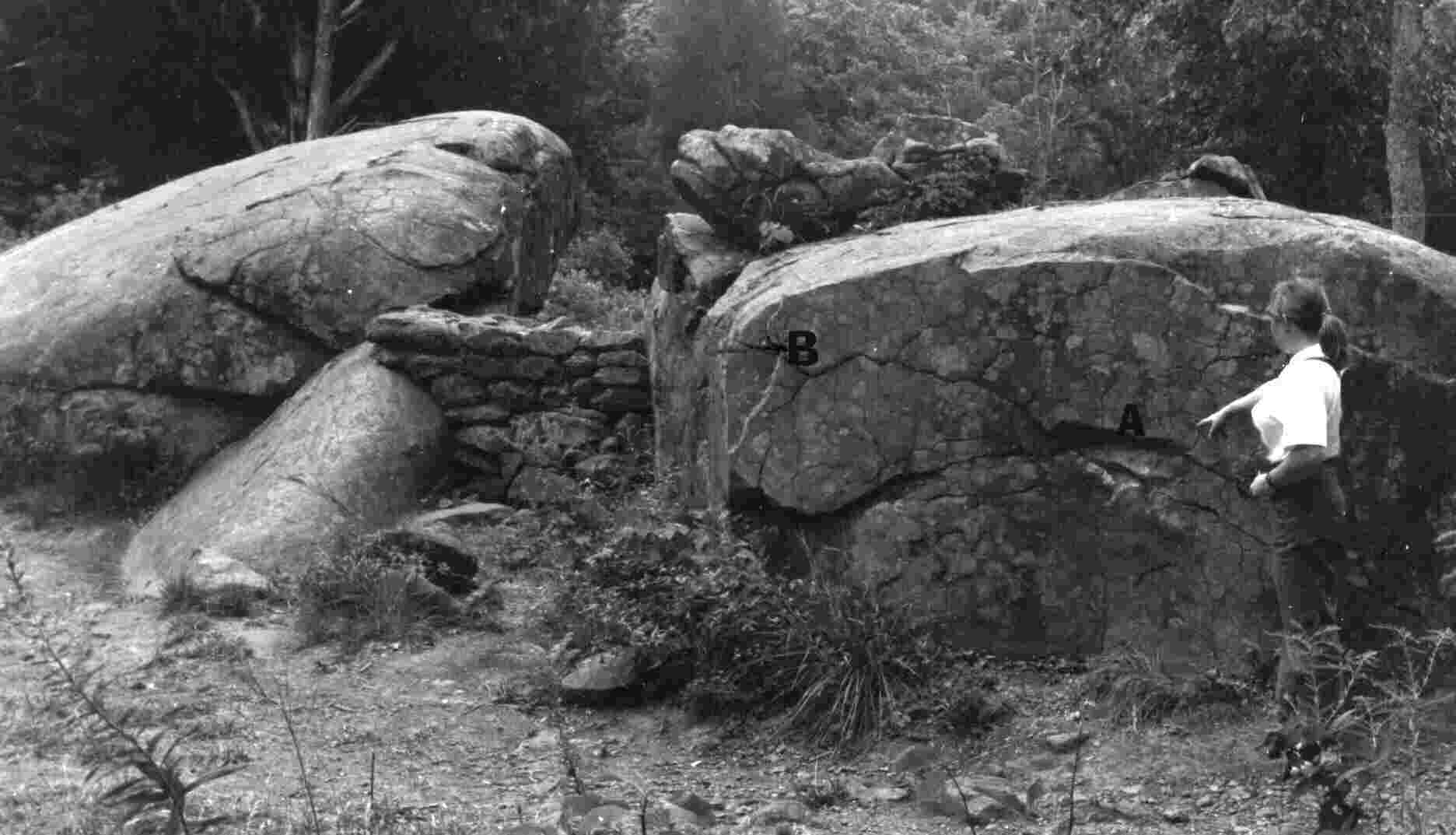 Photo by the artist.It is now August 1997 and I was able to
talk my wife
into leaving the car.
Photo by the artist.It is now August 1997 and I was able to
talk my wife
into leaving the car.
In this photo Carolyn points to a scar I think is consistent in
appearance to a direct shell-hit.
Another mark (B) at the upper left edge of the same rock is consistent
with possible flung shell
bits (shrapnel) from a hit close to but in front of the boulders of the
sharpshooter's "home". The
lost lower left boulder-edge could be shell induced but gravity played a
large role in its production and so I should not consider it herein . The
larger central "hit" I believe is evidence to Augustus Martin's percussion
shell . As you can discern by the little triangle at the lower center of
the scar, its depth passes beyond the scaling effects of exfoliation (which
is typical to the area showing left and right of Carolyn's head). Still, I
cannot think this hit should have caused all the visual cues I gathered
from my study of the possible effects of shell-fire to the area of the
"Sharpshooter's Home" photographs and elsewhere.
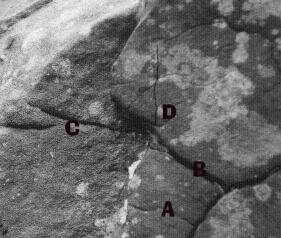
Close-up of my possible case-shot debris hit "B" in photo above. Strike
point of shell debris is at center. Note: first exfoliation rock layer has
been removed from the left side of the strike point. Normal weathering
is not evident. "A" is a small rounded edge cooling crack. "B" is a
large rounded-edge cooling crack. "C" is a much weaker rounded edge
cooling crack extending into the second layer of the granite's skin. All
cracks visible throughout the photo are also various cooling cracks.
Now here is the puzzler: The vertical hairline crack to the left of "D" is
not a cooling crack. Rather, it is a sharp-edged impact crack radiating
from what I suppose is that strike point. Well, that's my opinion. Next
time you visit the battlefield take a look and see what you think. Photo
by the artist
Thus, I believe the sharpshooter's death was incidental to another
shell hit. Perhaps a shell that
may have caused the suspicious and more superficial damage (B) to the
boulder. There is actual
visual evidence in the old photos to indicate a shell (more likely a
case-shot) exploded
somewhere in front of the "Home". Momentum debris then struck against and
toppled some of
the highest wall-rocks down upon the luckless sharpshooter - pinning his
legs, knocking him
dead or unconscious. It also cropped off a small 10 foot cedar directly
behind and in direct line
with the sharpshooter's hole and felled a 30-foot dead pine tree even
further back. Viewed from
LRT, this lucky shell hit and its effects on the trees, ground, and shrubs
beyond the "Home" may
have been easily misconstrued to be more of a miss than a hit. As I said,
the evidence is there
within those old photos and I will cover that further on.
Photo by the artist
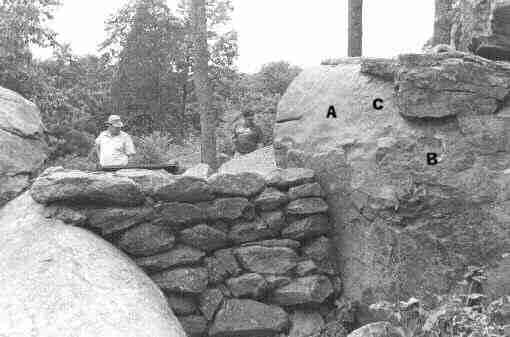 Here is
another view showing the front (facing LRT) side of the wall. The bald spot
at "A" is normal exfoliation and I could tell by looking at the "Home"
photo that this area was exposed well before the battle. It is smoother and
had lichen growing upon its surface (in photos from 1863, 1867). However,
"B" is very much newer and does not "play" by the general rules of geologic
break-down. Something beyond gravity and mechanical weathering was at work
here. And so I regard it as suspicious. "C" is the rougher surface which
indicates it is newer than the older pre-civil war smoother surface "A". It
may have likely scaled off the boulder's edge after the possible shell
debris hit at "B".
Here is
another view showing the front (facing LRT) side of the wall. The bald spot
at "A" is normal exfoliation and I could tell by looking at the "Home"
photo that this area was exposed well before the battle. It is smoother and
had lichen growing upon its surface (in photos from 1863, 1867). However,
"B" is very much newer and does not "play" by the general rules of geologic
break-down. Something beyond gravity and mechanical weathering was at work
here. And so I regard it as suspicious. "C" is the rougher surface which
indicates it is newer than the older pre-civil war smoother surface "A". It
may have likely scaled off the boulder's edge after the possible shell
debris hit at "B".



 Historians, authors, re-enactors, guides, etc. (and artists too), have
agreed this body belonged to
a regiment fighting in the "triangular field" area of the southern
termination of Houck's Ridge
on Thursday, the 2nd of July and second day of the battle.
However, if this were true, this body-supposedly found down the hill-
would have lain in the open for several days. By the time the photographers
found it, this body would be just as bloated and grotesque as all the other
bodies found and photographed in the area. Even a group of confederates
killed within the somewhat
shaded wood-line at the base of Round Top on the 2nd show
horrible bloating. These soldiers-I think Georgians killed by a case-shot
spray pattern from one of James Smith's Fourth N.Y. Battery rifled 10 PDR
Parrotts-were left to lay throughout the 3rd
(Friday), which was the hottest, most sunlit day of all occurring between
the time of battle and the
arrival of the photographers (for bloating, a day of heat and sunlight is
key for the necessary
fermentation to occur). After the 3rd, the weather turned cloudy
and
thunderstorms moved through the area. The photographers most likely took
this photo (as well as the sharpshooter's) on Tuesday or Wednesday, and,
according to all the photographs taken that day, the weather was still
overcast.
Historians, authors, re-enactors, guides, etc. (and artists too), have
agreed this body belonged to
a regiment fighting in the "triangular field" area of the southern
termination of Houck's Ridge
on Thursday, the 2nd of July and second day of the battle.
However, if this were true, this body-supposedly found down the hill-
would have lain in the open for several days. By the time the photographers
found it, this body would be just as bloated and grotesque as all the other
bodies found and photographed in the area. Even a group of confederates
killed within the somewhat
shaded wood-line at the base of Round Top on the 2nd show
horrible bloating. These soldiers-I think Georgians killed by a case-shot
spray pattern from one of James Smith's Fourth N.Y. Battery rifled 10 PDR
Parrotts-were left to lay throughout the 3rd
(Friday), which was the hottest, most sunlit day of all occurring between
the time of battle and the
arrival of the photographers (for bloating, a day of heat and sunlight is
key for the necessary
fermentation to occur). After the 3rd, the weather turned cloudy
and
thunderstorms moved through the area. The photographers most likely took
this photo (as well as the sharpshooter's) on Tuesday or Wednesday, and,
according to all the photographs taken that day, the weather was still
overcast.

 Photo by the artist.It is now August 1997 and I was able to
talk my wife
into leaving the car.
Photo by the artist.It is now August 1997 and I was able to
talk my wife
into leaving the car.

 Here is
another view showing the front (facing LRT) side of the wall. The bald spot
at "A" is normal exfoliation and I could tell by looking at the "Home"
photo that this area was exposed well before the battle. It is smoother and
had lichen growing upon its surface (in photos from 1863, 1867). However,
"B" is very much newer and does not "play" by the general rules of geologic
break-down. Something beyond gravity and mechanical weathering was at work
here. And so I regard it as suspicious. "C" is the rougher surface which
indicates it is newer than the older pre-civil war smoother surface "A". It
may have likely scaled off the boulder's edge after the possible shell
debris hit at "B".
Here is
another view showing the front (facing LRT) side of the wall. The bald spot
at "A" is normal exfoliation and I could tell by looking at the "Home"
photo that this area was exposed well before the battle. It is smoother and
had lichen growing upon its surface (in photos from 1863, 1867). However,
"B" is very much newer and does not "play" by the general rules of geologic
break-down. Something beyond gravity and mechanical weathering was at work
here. And so I regard it as suspicious. "C" is the rougher surface which
indicates it is newer than the older pre-civil war smoother surface "A". It
may have likely scaled off the boulder's edge after the possible shell
debris hit at "B".


